1939
SEPTEMBER
1939
Poland -
After Germany invaded Poland
on the 1st, Britain and
France demanded the withdrawal of German
forces. The
ultimatum expired on the 3rd, Prime
Minister Neville
Chamberlain broadcast to announce that Britain
was
at war with Germany.
Polish
Campaign - As
the Germans advanced into Poland, Russia
invaded from the east on the 17th
September. Warsaw surrendered to the
German Army on the
28th and next day the country was
partitioned in
accordance with the Soviet-German Pact
OCTOBER
1939
Polish
Campaign - With
Poland partitioned between Germany and
Russia, the last of the Polish Army
surrendered on 5th October. Poland
entered its long dark
years of brutality and oppression.
NOVEMBER
1939
Russo-Finnish
War
- Negotiations
on border changes and control of islands
in the Gulf of
Finland broke down and Russia invaded on
the 30th.
Fiercely resisted by the small Finnish
army, the war
dragged on to March 1940
1940
FEBRUARY
1940
Russo-Finnish
War
-
Britain and France planned to send aid
to Finland. This
would allow them to occupy Narvik in
northern Norway and
cut back Swedish iron ore supplies to
Germany.
MARCH
1940
Russo-Finnish
War - A peace treaty on the 13th
brought the war to a close, with Finland
ceding the
disputed territory to the Soviet Union.
APRIL
1940
Norway
- Germany invaded Norway on the 9th and
within a few week
totally subjugated the entire country
including the
Arctic North with its proximity to
Finland and Soviet Russia
JUNE
1940
Norway
- The surviving Norwegian troops
surrendered to the German Army on the
9th and the
Norwegian Campaign was over. The
Norwegian people would
not be liberated until after the German
surrender in May
1945. During that time, large German
forces were
maintained there at Hitler’s command in
case the
Allies should invade.
France
-
France
capitulated and
the Franco-German surrender document was
signed on the
22nd. Its provisions included German
occupation of the
Channel and Biscay coasts and
demilitarisation of the
French fleet under Axis control.
Eastern
Europe
- Soviet Russia occupied the
Baltic states of Lithuania,
Estonia and Latvia. In
July they were formally
incorporated into the USSR. Russia also
took over parts of Rumania.
JULY
1940
Russo-German
Cooperation
- Only 11 months before German
attacked
Russia, German raider “Komet” sailed for
the
Pacific through the North East Passage
across the top of
Siberia with the aid of Russian
icebreakers. She operated in the Pacific
and
Indian Oceans until returning to Germany
in November
1941.
AUGUST
1940
Eastern
Europe - The
Germans started planning the invasion of
Russia.
SEPTEMBER
1940
Axis
Powers -
Germany, Italy and Japan signed the
Tripartite Pact
in Berlin on the 27th. They agreed to
jointly oppose any
country joining the Allies at war - by
which they meant
the United States.
OCTOBER
1940
Eastern
Europe
- German troops occupied the Rumanian
oilfields.
Balkans
- On
the 28th, the Italians invaded Greece
from points
in Albania, but were soon driven back.
Fighting continued
on Albanian soil until April 1941.
NOVEMBER
1940
Eastern
Europe
- Hungary and Rumania
joined the Axis
Tripartite Pact on the 20th and 23rd.
Only Yugoslavia and
Bulgaria held out against German
pressure to
become members; the only countries in
Eastern Europe and
the Balkans not completely dominated by
the Axis or Russia.
DECEMBER
1940
Eastern
Europe - Hitler
ordered detailed planning for Operation
'Barbarossa' -
the invasion of Russia.
1941
MARCH
1941
Eastern
Europe and
Balkans - Bulgaria joined
the Tripartite Pact
on the 1st March and German troops
marched in. As of now,
only Yugoslavia in the Balkans
retained national
independence
Yugoslavia
- On the
25th Yugoslavia joined the Tripartite
Pact, but two days
later an anti-Nazi coup toppled the
Government.
APRIL
1941
Yugoslavia
and Greece - Germany invaded both
countries on the 6th. By the 12th they
entered Belgrade
and within another five days the
Yugoslav Army had
surrendered. Greek forces in Albania and
Greece suffered
the same fate. Starting on the 24th over
a period of five
days, 50,000 British, Australian and New
Zealand troops
were evacuated to Crete and Egypt in
Operation 'Demon'.
The Germans occupied Athens on the 27th.
Far
East
- Five Year Neutrality Pact between
Japan and Russia benefited both powers.
Russia
could
free troops for Europe and Japan
concentrate on expansion southwards.
MAY
1941
Britain
- Heavy raids on Belfast in Northern
Ireland, the
Scottish Clyde, Liverpool and especially
London on the
night of the 10th/11th marked the
virtual end of the
Blitz. The bulk of the Luftwaffe was now
transferring
east for the attack on Russia. RAF raids
on Germany continued, and grew
as a major plank in British and Allied
strategy for the
defeat of Germany.
Malta
-
The transfer of many German aircraft
from Sicily for the
attack on Russia
brought some relief to Malta.
JUNE
1941
|
Germany
Attacked Russia
Eastern
Front - On
the 22nd, the German attack
on Russia - Operation
'Barbarossa' (see
map above) - started
with the eventual aim of
destroying the Russian
Armies and occupying the
whole of the country west of
the line Archangel
in the Arctic to the Caspian
Sea. Germany and its
Axis partners invaded from
the Baltic to the
Black Sea: North
through the Baltic States
to Leningrad. Further north
still Finland would
regain its lost territories;
in the centre
through Minsk and Smolensk
and on to Moscow; and in the
south
towards Kiev and the Crimea
Peninsular in the
Ukraine, and then to Kharkov
and Rostov before
heading for Stalingrad and
the oilfields of the
Caucasus.
Italy
and Rumania
declared war
on Russia on the 22nd. Finland
followed on the 26th and Hungary
on the
27th.
Allied
Convoys to
Russia
The
invasion of
Russia soon led to the
introduction of the
Russian or Arctic convoys
with their dreadful
conditions and after some
months had elapsed,
high losses in men and
ships. However, the Royal
Navy's presence in the
Arctic was first made
known in August when
submarines started
operating, with some success
against German
shipping supporting the Axis
attack from Norway
towards Murmansk. The port
was never captured.
Conditions with these
convoys were at the very
least difficult. Both summer
and winter routes
were close to good German
bases in Norway from
which U-boats, aircraft and
surface ships could
operate. In the long winter
months there was
terrible weather and intense
cold, and in summer,
continual daylight. Many
considered that no ships
would get through. The first
convoy sailed in
August and, by the end of
the year, over 100
merchantmen had set out in
both directions. Only
one was lost to a U-boat. In
1942 the picture
changed considerably. (See
also the more detailed "Russian
Convoys",
starting with
Eastern
Front
and Russian Convoys, Jun
1941-Oct 1942.)
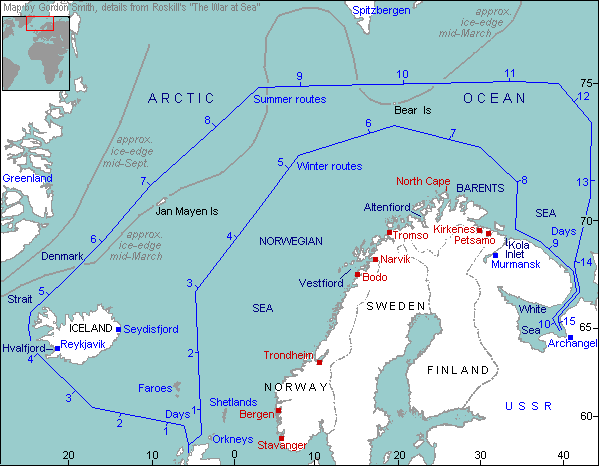
|
JULY 1941
Eastern
Front - German
forces advanced in all sectors, and in
the centre
captured Minsk,
capital of Byelorussia and surrounded
Smolensk on the road to Moscow. Russian
losses in men and
material were immense. On the 12th, an
Anglo-Soviet
Mutual Assistance Pact was signed in
Moscow. Both
countries agreed not to seek separate
peace negotiations
with the Axis powers.
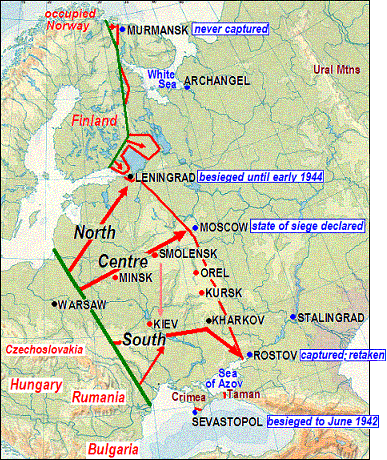
Eastern
Front, June-November 1941
AUGUST
1941
United
States - Winston Churchill crossed
the Atlantic to
meet President Roosevelt off Argentia,
Newfoundland
between the 9th and 12th. Together they
drafted the Atlantic
Charter
setting out their aims for war and
peace. This was signed
by Britain, the United States and 13
Allied governments
in September.
The attack north
on Leningrad continued. In the centre
Smolensk
was
taken, but the drive on Moscow
was halted. Instead German
forces were directed south to help
capture
Kiev in the Ukraine.
Middle
East - The possibility
of a pro-Axis coup d'etat led to
Anglo-Soviet forces going into
Persia
on the 25th from points in Iraq, the
Persian Gulf
and Russia. A cease-fire was announced
within
four days, but later violations led to
Teheran
being occupied in the middle of
September.
SEPTEMBER
1941
In
the
north the siege of Leningrad
was
about
to start, and would not be lifted
completely until early 1944. Kiev
in
the south was captured and
Centre Army
Group released to continue the Moscow
offensive. Further
south still, the Crimea was cut
off and German forces
drioe on towards Rostov-on-Don.
OCTOBER
1941
As
German
forces in the centre approached
Moscow a state of siege was
declared, but the offensive was
temporarily
halted at the end of the month. In the south
Kharkov, east of Kiev
in the
Ukraine, fell.
NOVEMBER
1941
The
German
centre advance on Moscow was
restarted and
troops were soon on the capital's
outskirts. In
the south they had driven right
into the Crimea. Only
Sevastopol held out and the siege
lasted until June 1942. Further east
Rostov-on-Don was captured, but the
Russians
re-took the city.
DECEMBER
1941
Declarations
of
War
-
In a series of diplomatic moves,
numerous
declarations of war were made: 5th-6th
December
- Britain, Australia, Canada, New
Zealand and South Africa declared war on
Finland,
Hungary and Rumania. 11th-13th
December -
Germany, Italy, Rumania, Bulgaria and
Hungary against the United States.
28th December-14th January -
Britain,
Australia, New Zealand and South Africa
against Bulgaria.
As the
Germans
halted outside Moscow, the
Russians launched a major Counter-Offensive
starting
from near Leningrad in the north
down to
the Ukrainian city of Kharkov in the south.
By April 1942 Russian forces had
regained much
lost territory, but few major cities.
The siege
of Leningrad continued.
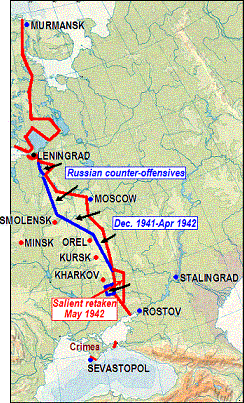
Eastern
Front,
December 1941-May 1942
1942
JANUARY
1942
Arcadia
Conference - In late December and
early
January, Winston Churchill and President
Roosevelt with their Chiefs of Staff met
in
Washington DC. They agreed to the
setting up of a
Combined Chiefs of Staff Committee and
to the
defeat of Germany as the first priority.
On 1st
January the United Nations Pact
embodying
the principles of the Atlantic Charter
was signed
in Washington by 26 countries.
The Russian
advance continued to make headway. In
the centre
it reached to within 70 miles of
Smolensk. To the
south they drove a deep salient into the
German
lines south of Kharkov in the Ukraine.
However
German resistance grew as the Russians
begin to
over-extend themselves.
APRIL
1942
The
Russian
Counter-Offensive launched
in December 1941 in the north
and centre came to a halt.
Territory had been
regained but few cities. The Russians
maintained their
hold on the Kharkov salient in the south.
MAY
1942
In the
south,
Russian forces attacked from the salient
below the
Ukrainian city of
Kharkov and
made
some progress, but the Germans
counter-attacked and
soon encircled and captured the
Russians. The Germans
pushed on beyond Kharkov ready for the
main Spring
Offensive.
JUNE
1942
United
States -
Winston Churchill flew to Washington DC
for
another series of meetings with
President
Roosevelt. They agreed to share nuclear
research
and concentrate the work in the United
States.
Agreement did not come so easily on the
question
of where to open a Second Front in 1942.
The
Americans wanted to land in France to
take
pressure off the Russians, but the
British
considered this impossible at present
and
proposed the invasion of French North
Africa. The
President did not come to accept this
until July.
Czechoslovakia
-
Reinhard Heydrich, German 'Protector' of
Czechoslovakia
died from wounds sustained in an
assassination
attempt in May. In part reprisal, the
village of
Lidice was wiped out and its people
murdered.
Towards the
end of
the month the Russians started to
evacuate Sevastopol and by early July
all the Crimea
was
in German Hands. By this
time the Germans had
started their Spring
Attack
in the south with the aim of
taking Rostov-on-Don and pushing further
south towards the vital oilfields
of the Caucasus. Meanwhile, from the
area
of Kursk and Kharkov, a second army
group would
move on Stalingrad to protect the left
flank of what
was initially the main thrust to the
south.
Stalingrad later dictated the outcome of
the
entire campaign.
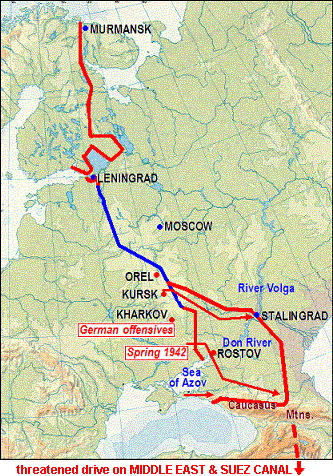
Eastern
Front, June-October
1942
JULY
1942
In the south
the German Spring Offensive
continued with the taking
of Rostov-on-Don. After
crossing the Don
River they pushed on into into the
Caucasus. Meanwhile the protective
left flank army group was approaching
Stalingrad. The German advance into
the Caucacus came at a critical time for
the
North African campaign, opening up the
possibility of a German link-up in the
Middle
East. The loss of the region's oil and
the
potential for a German-Japanese meeting
in India
could have proved fatal for the Allies.
AUGUST
1942
The
south continued
to be the main focus of this long and
bitterly contested
front and remained so until January
1943. In the
Stalingrad area the German reached the
River Volga and
were within a few miles of the city at
the start of the
Battle
of Stalingrad.
They broke into the suburbs in September
and the fighting
increased in intensity as the Russians
struggled to hold
on to the west bank of the Volga. Further
south
still, the German invaders reached the
Caucasus Mountains, but thereafter made
slow
progress.
OCTOBER
1942
Still
concentrating
on the south, the Germans made
little progress in the Caucasus. By
November they were being worn down and
the Russians started to go over to the
offensive. Hitler
decided to take Stalingrad and major
attacks were started in October
and then November. Neither attacks
succeeded in merciless
factory-to-factory, house-to-house,
room-to-room
fighting.
NOVEMBER
1942
In
the
south, as the German forces in
the Caucasus and within Stalingrad
were slowly
ground down, the Russians
started a long-planned
Major Offensive to relieve
the city and trap the
invaders in the Caucasus. Along 50-mile
fronts to
the north and the south of Stalingrad,
two large
armies broke through the largely
Rumanian
defenders. Before the month was out the
Russian
pincers had met and Gen Paulus’ Sixth
Army
was surrounded.
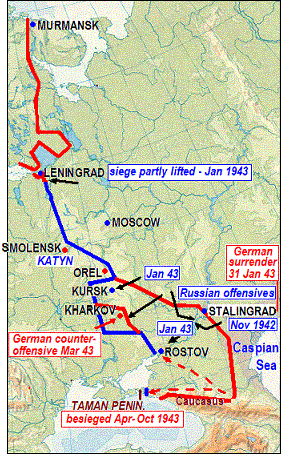
Eastern
Front, November
1942-May 1943
DECEMBER
1942
In
the
south, a scratch German force
tried to
reach Stalingrad from the southwest but
was soon
driven back. Further north, the Russians
resumed
their push and annihilated an Italian
army. By
now the Germans in the Caucasus
were under
heavy pressure. Fearing the Russians
would reach
Rostov-on-Don and trap them, they
started to
withdraw from the oilfields considered
so
important by Hitler.
1943
JANUARY
1943
Russian
strength
was now great enough to attack along
other parts of the front as well as in
the south.
In the north they managed to
open a narrow
corridor through to Leningrad.
The siege was partially
lifted, but another year was needed to
complete
its liberation. The offensive in the centre/south
continued with the Russians aiming (from
north to
south) for Kursk, Kharkov and
Rostov-on-Don. In the south
itself, the pressure on the trapped
Germans at
Stalingrad was increased. A powerful
attack
starting early in the month forced Gen
Paulus and
the remnants of Sixth Army to surrender
on the
31st January with the last troops giving
in on
the 2nd February. The Battle of
Stalingrad
was
at
last over. Further
south still German forces in the
Caucasus retreated as the Russian
attacks gathered momentum. Those who
coukd,
escaped through Rostov-on-Don before its
inevitable
fall.
FEBRUARY
1943
By
mid-February
in the centre/south the Russians
had
liberated the cities of Kursk,
Kharkov and
Rostov-on-Don, but within a
matter of days
German forces started a successful
counter-attack around
Kharkov. In the south with the
Russian capture of
Rostov-on-Don, those Germans left in the
Caucasus were
driven back towards the Taman Peninsula
opposite the Crimea.
MARCH
1943
Until
now the
Germans had held on to the salients in
the Moscow area
left over from the Russian winter
offensive of 1941/42 in
the north and centre.
Under attack they
pulled back and straightened their
lines. In the centre
and south, the Germans retook
Kharkov, but the
Russian Army held on to the salient
around Kursk. As the
front stabilised both sides prepared for
the coming Battle of Kursk - the
greatest tank battle of the
war.
APRIL
1943
War
Crimes
- The site of the massacre of Polish
officers was found at Katyn near
Smolensk: the Russians and Germans
accused each other of
the atrocity.
In
the south
the Russians squeezed the Germans
trapped in the Caucasus
further into the Taman
Peninsula across from the
Crimea. Here they
held out for a further six months until
October 1943.
MAY
1943
Resistance
Forces - In occupied Europe,
Tito's partisan armies
continued to hold down large numbers of
German troops in Yugoslavia.
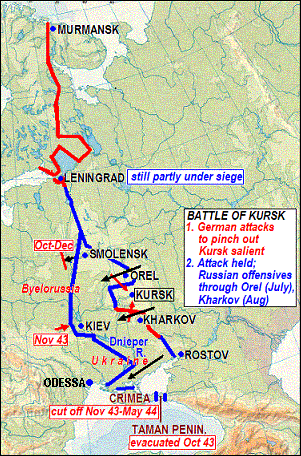
Eastern
Front, June-December 1943
JULY 1943
There
was
little activity in the north and
Leningrad had to wait until early
1944 for the siege to be fully lifted.
It was a
different matter in the centre/south
where
the Battle of Kursk
was
fought.
The Germans attacked
the 100-mile wide salient around Kursk
from the
Orel in the north and Kharkov in the
south. Total
forces engaged on both sides included
6,000 tanks
and 5,000 aircraft. Russian defences
were well
prepared and in depth and the Germans
made little
progress. Within a week they had ground
to a
halt. Losses were heavy on both sides.
Now the
Russian armies launched the first of
numerous
offensives in these sectors, which by
year's end
saw them reaching Byelorussia and
recapturing more than
half the Ukraine. The first attacks were
north of
Kursk against the German salient around
Orel. In
early August it was the turn of Kharkov
to the
south.
AUGUST
1943
From
east
of Smolensk south to the Sea of Azov the
Russians attacked and pushed forward all
along
the line: in the centre towards
Smolensk itself; in the
centre/south first Orel
and then
Kharkov
were
captured, followed by an
advance towards the Ukrainian capital of
Kiev; in the south from
the Rostov-on-Don area towards Odessa,
threatening to trap the
Germans in the Crimea.
SEPTEMBER
1943
The
Russians
continue to push forward in the centre
and south, capturing
Smolensk on the 25th
September. Thereafter
they made little progress in this area
for the
rest of 1943.
British
Aegean
Campaign - With the surrender of
Italy,
Winston Churchill wanted to seize the
Italian Dodecanese
islands in the southern Aegean before
the Germans could
establish themselves. From here the
Allies could threaten
Greece, support Turkey and
(with an eye on
the post-war world by Mr Churchill)
forestall future
Russian
moves
in the
Balkans,
but the
Americans and some British commanders
were lukewarm on
what they saw as a sideshow compared
with the battle for
Italy. Insufficient forces and
especially aircraft were
made available, and the Germans soon
took Rhodes from
where, together with other bases, they
maintained air
superiority throughout the coming
campaign.
OCTOBER
1943
In
the centre
and south the Russians still
made little progress
against fierce German resistance. Further
south
still the remaining German troops in the
Caucasus
evacuated the Taman Peninsula
and were ferried across to the Crimea.
NOVEMBER
1943
In
the centre/south,
Russian forces captured Kiev,
capital of the Ukraine on the 6th and
pushed on. However,
the Germans managed to counter-attack
and recaptured some
of the towns to the west of the city. A
larger German
counter-offensive in the same area faded
out by early
December. Further south the
attacks towards Odessa
finally cut off the Germans in the
Crimea where they held out until May
1944.
DECEMBER
1943
Since
October
1943, five Russian attacks in the centre
had been
launched against the Germans west of
Smolensk. The greatly outnumbered
defenders
had held on, but the Russians now had a
foothold back in Byelorussia. In the centre/south
all
the Ukraine east of the Dnieper River
together with deep
bridgeheads across much of its length
were now in Russian
hands. They prepared to recover the rest
of the Ukraine,
push into the Crimea and move on Poland
and Rumania.
1944
JANUARY
1944
Now
the
German invaders in the north
felt the
weight of Russian attacks. A series of
offensives
drove them back from the gates of
Leningrad by the end of
January. By early
March the Russian armies had regained a
large
chunk of Russian territory that took
them just
over the border of northern Estonia
and close to Latvia. Here
they stayed until July. Meanwhile, the
massive
assaults continued in the centre/south
from north of Kiev down to the Black
Sea, and the
ground lost to the west of Kiev was soon
regained. The Russians pushed on and
early in the
month crossed into the southeast corner
of pre-war
Poland.
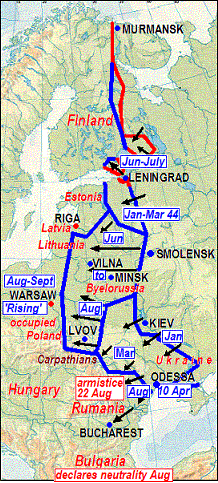
Eastern
Front,
January-August 1944
FEBRUARY
1944
In
the centre the Russians moved
further into
Poland. All the time German
commanders
were severely restricted by Hitler's
refusal to
allow them to fall back on more
defensible
positions. Large formations found
themselves
encircled by the Russians and the
Germans'
limited resources were used up in
rescuing them.
MARCH
1944
Nearly
all
the Ukraine
was
now
back in Russian hands
and in the south the advance
towards the
southwest brought the Russians to the
foothills
of the Carpathian mountains, just inside
pre-war Rumania. Thoroughly
concerned
about the potential collapse of the
Balkans,
Hitler ordered troops into Hungary
to prevent the country
leaving the Axis. As this happened the Finnish
Government was trying to
negotiate an armistice with Russia.
APRIL
1944
In
the
south the Russians started the
task of
clearing the Crimea. Further west, on
the 10th they
captured the major Black Sea port of Odessa.
MAY
1944
Air War
- In one
facet of the air war, a V-2 rocket
crashed in Poland near Warsaw and
resistance groups
managed to arrange for the parts to be
successfully
airlifted to Britain.
Against
fierce German
resistance, the Russians in the south
had now
re-captured all the Ukraine
including the Crimea.
In the centre, they were
over the border into pre-war Poland
and Rumania.
JUNE
1944
Normandy
Invasion 6th June, Operation
'Overlord'
In
the far
north Russia attacked into
southern Finland on the 10th in
order to force the
government to the negotiation table.
Fighting carried on
into July, but by early September a
cease-fire was in
effect. In the centre of the
main front, the Russians
started the First of
their major summer offensives
on the 23rd from around Smolensk. The
aim was to clear the Germans out of
Byelorussia and head on for Warsaw, East
Prussia and the Baltic through
Lithuania.
JULY
1944
Germany
- In the
20th July Bomb Plot, a device left by
Col von
Stauffenberg in Hitler’s East Prussia
headquarters only injures him
slightly.
The attacks
in the
centre pushed on. Minsk,
capital of Byelorussia
was taken
by the 4th and by mid-month all
the Russian republic had been liberated.
Vilna, disputed capital
of Lithuania,
was captured on the 13th. By
the end of July
the Russians were approaching the
outskirts of Warsaw. In the north,
the Second Main
Phase of the
summer offensive got underway with the
aim of ejecting
the Germans from the Baltic states. The
Third Phase started in
the middle of the month
in the centre/south from the
Ukraine into southern Poland. Lvov
was
taken on the 27th.
AUGUST
1944
Nearly
all pre-war Russia had
now
been liberated. On the 1st, the
Polish Home Army launched the Warsaw
Rising
against their German
oppressors. With little help from
outside, least of all
the Russians, the fight went on through
August and
September 1944 until the Poles were
finally crushed with
great brutality. Around 200,000 died by
the time the
survivors surrendered on 2nd October
1944. Further south
the Russians gained a bridgehead over
the River Vistula and their forward
lines ran along
much of the length of the Carpathian
Mountains by month's end. By now running
short of supplies and facing increasing
German
resistance, this sector was stabilised
until January
1945. However the Fourth
Phase of the Summer offensive
started in
the far south, aimed at clearing the
Balkans. The Russian armies attacked on
the 20th from the Ukraine south and west
into Rumania. Events moved
rapidly. Three days
later Rumania accepted the Russian
armistice terms, on
the 25th declared war on Germany, and by
the 31st the
Russians were entering Bucharest.
Now Bulgaria tried to declare
its neutrality and
withdraw from the war, just as the
Russian forces swung
west and north towards Hungary
and on to Yugoslavia threatening
to cut off the Germans
in Greece.
SEPTEMBER
1944
In
the far north Finland agreed to
a cease-fire on
the 4th and six days later in Moscow
signed an armistice
with Russia, followed by one with the
Allies. By
mid-month the Finns were effectively at
war with Germany
although the formal declaration was not
made until March
1945. On the Baltic front, major attacks
continued into Estonia and
Latvia, and the Estonian capital
of Tallinn
was
captured on the 22nd. In the
Balkans, Rumania signed an
Allied armistice in Moscow on the
12th, by which time its troops were in
battle alongside
the Russians. The country was almost
free of the Germans
by the end of the month. From Rumania,
the Russians
reached the eastern border of Yugoslavia
by the 6th and crossed into
southern
Hungary before
September was out. Russia declared war
on Bulgaria
on the 5th, which in turn declared
against Germany three
days later as Russian forces crossed
into the country
near the Black Sea. They enter Sofia
on the 16th and at the end of
October signed an armistice with the
Allied powers. By
then Bulgarian troops were attacking
into Yugoslavia with
the Russians
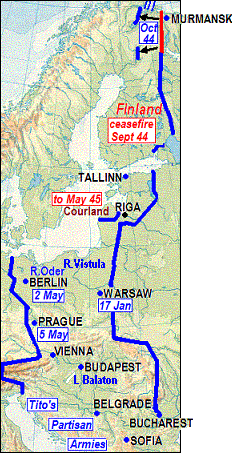
Eastern
Front,
September 1944-May 1945
OCTOBER
1944
In the Arctic,
the Russians started a
series of attacks and amphibious hops
which by
the end of the month had driven the
Germans back
from the Murmansk area just over the
border into
Norway. The Russians, now joined
by
Norwegian troops, came to a halt. Still
in the
north in the Baltic States, Riga
capital of Latvia was
captured on the 15th. By then the
Russians had
reached the Baltic north of Memel, which
eventually fell in
January 1945. German troops fell back in
to the Courland
Peninsula of
Latvia and held out there until May
1945, but by
the end of October most of Estonia,
Latvia
and Lithuania
were
free
of the Germans.
Following an abortive uprising in
eastern Czechoslovakia in late
August, the
Russians now attacked over the
Carpathian
mountains from southern Poland and were
cross the
border in mid-month. In the Balkans, the
struggle
up through Hungary continued,
but the Russians
could only reach the outskirts of
Budapest in early November.
Meanwhile the Eastern Allies were
advancing into Yugoslavia and
joined forces with
units of Marshall Tito's partisan armies
on the
4th. Belgrade fell on
the 20th.
NOVEMBER
1944
The
main
activity was in Hungary where
the Russians still
battled towards Budapest, and in the
Balkans as southern Yugoslavia
was cleared
by the Eastern
Allies.
Greece
&
Albania - By mid-month Greece
was
free of those Germans that
could escape and British troops had
landed in the
north. They also had the job of
disarming the
various resistance movements. In Albania
the Germans were pulling
out and on the 21st the capital of
Tirana
was
occupied
by Albanian partisans.
DECEMBER
1944
In
Hungary
the
Russians attack towards Budapest,
reaching Lake Balaton
early in the month and encircling the
city at
Christmas. Following the setting up of a
provisional Hungarian Government in the
Russian-held area, war was declared on
Germany on
the 31st and an armistice signed with
the Allies
in late January 1945.
1945
JANUARY
1945
All along the
Polish
Vistula front the Russians started a
major offensive
through Warsaw directed at Berlin.
Devastated Warsaw fell
on the 17th and by the end of
the month they had gained a huge wedge
of territory
taking them over the border of Germany
to the River Oder only 60 miles
from the German capital. The Germans
were now cut off in East Prussia and
some 1 1/2 million servicemen
and civilians were evacuated by the end
of the war. To
the south, the Eastern Allies continued
to fight their
way through Czechoslovakia as
the Russians struggled to capture
Budapest in Hungary.
FEBRUARY
1945
Yalta
Conference - For a week early in
the month, Prime
Minister Churchill, President Roosevelt
and Generalissimo
Stalin met at Yalta in
the Crimea. With the Russians advancing
through Eastern
Europe and agreement on the future
frontiers of Poland
and the division of Germany into four
occupation zones,
the shape of much of post-war Europe was
determined.
Stalin agreed to declare war on Japan
once the war in the
west was over.
Having
penetrated
into Germany the Russians pushed
out north towards the
Baltic coast and southwest, so that by
the beginning of
March they were establishing themselves
along the Oder-Niesse line of rivers. In
Hungary, Budapest
finally fell on the 13th.
MARCH
1945
By
the end of
March the Russians had taken most of the
Baltic coast of Germany and Poland
east of the River Oder and captured Gdynia
and
Danzig. They were now
poised along the
Oder-Niesse Line ready for the final
attack towards Berlin. To the south, the
Eastern Allies
continued their progress into Czechoslovakia.
In Hungary the Germans made
their last
important counter-offensive of the war
around the Lake
Balaton area. By mid-month they had been
stopped and the
Russians drove on towards eastern Austria.
APRIL
1945
As the
Eastern Allies
fought through Czechoslovakia
towards Prague, Hungary was
finally freed of the Germans, and the
Russians pushed
into Austria, capturing Vienna
on the 13th. To the north, as the
Western Allies came to a halt along the
line of the River
Elbe, the Russians started their final,
massive drive
into eastern
Germany from the
Oder-Neisse Line. They had surrounded
the German capital
by the 25th and the Battle for
Berlin got underway.
Germany -
The End of
Adolf Hitler: As the month drew to
a close and the
Allies completed the destruction of the
German Reich,
Heinrich Himmler tried to surrender to
Britain and the
United States through Swedish
intermediaries, but
anything short of unconditional
surrender was refused. On
the 29th in his Berlin bunker, Hitler
married Eva Braun
and nominated Grand-Adm Doenitz as his
successor. Next
day Hitler and his wife committed
suicide and Doenitz
became Fuehrer on 1st May.
MAY
1945
Western
Front
- In the last week of the war in
Europe, US
First and Ninth Armies stood along the
west bank of the River Elbe. To their
north, British Second
Army reached the Baltic on
the 2nd and next day took Hamburg. In
the south, US Third
Army pushed into Czechoslovakia as far
as Pilsen and Austria around Linz, and
Seventh Army into
Austria and through Innsbruck before
crossing the Brenner
Pass into Italy.
There the
Western
Allies
stopped.
On the 4th outside Hamburg, German
envoys surrendered
their forces in Holland, Denmark and
northwest Germany to
Field Marshal Montgomery.
Eastern
Front - Berlin
fell to the Russian Army on the
2nd. Fighting continued in
Czechoslovakia and Austria and,
on the 5th, resistance forces rose to
take over Prague. A
few days later the last major
German units surrendered to the Russians
to the east of
the Czech capital.
Surrender
and
Occupation - At Gen Eisenhower's
HQ at Rheims in
France on the 7th, the unconditional surrender
of
Germany
was
signed
to
take effect from midnight on the 8th -
VE day. On the
9th it was ratified in Berlin and signed
for the Allies
by Air Chief Marshall Tedder (as Gen
Eisenhower's Deputy)
and Russian
Marshal Zhukov. As the
last remaining German forces surrendered
in France,
Germany, Norway and elsewhere, and the
Allies completed
the liberation of all Europe from their
hold, the four
major powers moved into their zones of
occupation in
Germany and Austria. The war in
Europe was over.
JULY
1945
Potsdam
Conference
- In the second half of the month,
the
heads of the three great powers met at
Potsdam outside
Berlin to continue discussing the future
of Europe and
final defeat of Japan. By the end of the
conference only Stalin remained of the
original three
major Allied leaders who had met in the
past. Accompanied
by President Truman of the United States
for the first
time, Winston Churchill was only there
at the start. On
the 26th the Potsdam Declaration was
broadcast, demanding
the unconditional surrender of Japan.
AUGUST
1945
Far
East -
Russia declared
war on Japan on the
8th and invaded Manchuria early next day
overwhelming the
Japanese defenders.